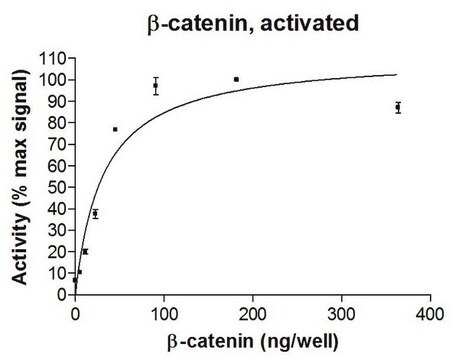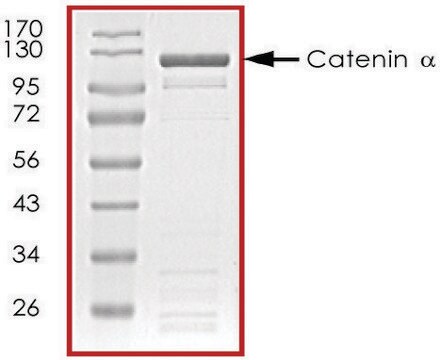SRP5172
Catenin β, GST tagged human
recombinant, expressed in baculovirus infected Sf9 cells, ≥70% (SDS-PAGE), buffered aqueous glycerol solution
Synonim(y):
CTNNB, FLJ25606
About This Item
Polecane produkty
pochodzenie biologiczne
human
rekombinowane
expressed in baculovirus infected Sf9 cells
Próba
≥70% (SDS-PAGE)
Formularz
buffered aqueous glycerol solution
masa cząsteczkowa
~115 kDa
metody
activity assay: suitable
rozpuszczalność
water: soluble
przydatność
suitable for molecular biology
numer dostępu NCBI
Zastosowanie
cell analysis
Warunki transportu
dry ice
temp. przechowywania
−70°C
informacje o genach
human ... CTNNB1(1499)
Opis ogólny
Zastosowanie
- jako składnik buforu kinazy białkowej do testu kinazy in vitro
- w teście cytrulinacji in vit ro w celu scharakteryzowania cytrulinacji β-kateniny
- do przeprowadzania badań przesiewowych czynników różnicujących
Działania biochem./fizjol.
Postać fizyczna
Uwaga dotycząca przygotowania
Kod klasy składowania
10 - Combustible liquids
Klasa zagrożenia wodnego (WGK)
WGK 1
Temperatura zapłonu (°F)
Not applicable
Temperatura zapłonu (°C)
Not applicable
Wybierz jedną z najnowszych wersji:
Certyfikaty analizy (CoA)
Nie widzisz odpowiedniej wersji?
Jeśli potrzebujesz konkretnej wersji, możesz wyszukać konkretny certyfikat według numeru partii lub serii.
Masz już ten produkt?
Dokumenty związane z niedawno zakupionymi produktami zostały zamieszczone w Bibliotece dokumentów.
Nasz zespół naukowców ma doświadczenie we wszystkich obszarach badań, w tym w naukach przyrodniczych, materiałoznawstwie, syntezie chemicznej, chromatografii, analityce i wielu innych dziedzinach.
Skontaktuj się z zespołem ds. pomocy technicznej








